
 My grand niece, Raelynn Masterson is turning 13 today. Turning 13 is an exciting, mixed up, trying time in that persons life, but Raelynn…or Rae, as she is known to her family, is taking it pretty much in stride. She has always been easy going, and maybe it’s that style that lets her make a smooth transition into the teenage years. The journey from child to young adult is filled with ups and downs, but Raelynn doesn’t seem to be too shook up about it…unlike her mom, my niece, Dustie Masterson. Dustie is having a bit of a hard time believing that her first born…while no longer a baby, yet always her baby, is growing up so very fast. Dustie calls this by far their “biggest adventure” yet. I think that any parent of children over the age of 13 knows exactly what Dustie means. I don’t think any parent is truly ready for their kids to grow up.
My grand niece, Raelynn Masterson is turning 13 today. Turning 13 is an exciting, mixed up, trying time in that persons life, but Raelynn…or Rae, as she is known to her family, is taking it pretty much in stride. She has always been easy going, and maybe it’s that style that lets her make a smooth transition into the teenage years. The journey from child to young adult is filled with ups and downs, but Raelynn doesn’t seem to be too shook up about it…unlike her mom, my niece, Dustie Masterson. Dustie is having a bit of a hard time believing that her first born…while no longer a baby, yet always her baby, is growing up so very fast. Dustie calls this by far their “biggest adventure” yet. I think that any parent of children over the age of 13 knows exactly what Dustie means. I don’t think any parent is truly ready for their kids to grow up.
 Raelynn is the big sister to Matt and Anna, and younger half-sister to Christina, who lives in Colorado. For some time now, Raelynn has been the “little mom” to her younger siblings. She is helpful to her mom and dad, and doesn’t present them with a ton of drama…unless her younger brother and sister provoke her, that is. She is so motherly sometimes that her mom has to remind her that in reality she is not the mom, but that often happens with older children. She is a kind person too, so I’m sure that keeps sibling relationships on an even keel. Many people really have no ability to empathize with others, but Raelynn is compassionate and has an understanding of people that surpasses her years on this earth.
Raelynn is the big sister to Matt and Anna, and younger half-sister to Christina, who lives in Colorado. For some time now, Raelynn has been the “little mom” to her younger siblings. She is helpful to her mom and dad, and doesn’t present them with a ton of drama…unless her younger brother and sister provoke her, that is. She is so motherly sometimes that her mom has to remind her that in reality she is not the mom, but that often happens with older children. She is a kind person too, so I’m sure that keeps sibling relationships on an even keel. Many people really have no ability to empathize with others, but Raelynn is compassionate and has an understanding of people that surpasses her years on this earth.
These days Raelynn is into science and boys…and not necessarily in that order. I suppose that might be viewed as an odd combination, but it works for her. The Science Zone is a really big deal here in town, and she loves going there. They even have summer classes for the kids. Dustie signed Raelynn up for three this year. The first one was a Dissection Class, and is definitely the one Raelynn likes the least…probably because of her love 
 of animals. The second class was on Water, which she really enjoyed, but it was the class where she was able to help the instructor with the animals that really did it for Raelynn. When her mom picked Raelynn up, she was excitedly telling her that the Iguana and the Science Zone doesn’t like anyone, but really took to Raelynn. She was so happy about that. Raelynn loves to read, and is keep a journal, which is seriously private, of course. Raelynn is such a sweet girl, and a great blessing to her family. Today is Raelynn’s birthday. Happy birthday Raelynn!! Have a great day!! We love you!!
of animals. The second class was on Water, which she really enjoyed, but it was the class where she was able to help the instructor with the animals that really did it for Raelynn. When her mom picked Raelynn up, she was excitedly telling her that the Iguana and the Science Zone doesn’t like anyone, but really took to Raelynn. She was so happy about that. Raelynn loves to read, and is keep a journal, which is seriously private, of course. Raelynn is such a sweet girl, and a great blessing to her family. Today is Raelynn’s birthday. Happy birthday Raelynn!! Have a great day!! We love you!!

 World War II saw the shooting down of more of our military planes that most of us want to think about. We saw the loss by planes being shot down, but also transport planes lost, and planes lost in training accidents. The loss was felt deeply. I realize that accidents are a fact of life and during wartime they are probably more likely to happen than other times, but some accidents just have a bigger impact on our emotions than others. Such was the case of the accident of July 28, 1945.
World War II saw the shooting down of more of our military planes that most of us want to think about. We saw the loss by planes being shot down, but also transport planes lost, and planes lost in training accidents. The loss was felt deeply. I realize that accidents are a fact of life and during wartime they are probably more likely to happen than other times, but some accidents just have a bigger impact on our emotions than others. Such was the case of the accident of July 28, 1945.
That morning, the skies over New York City were filled with heavy fog. A B-52 Mitchell Bomber with two pilots and one passenger aboard, en route from New Bedford, Massachusetts, to LaGuardia Airport in New York City, was diverted because the fog was so thick. As it came into the metropolitan area on that Saturday morning, air-traffic controllers instructed the plane to fly to Newark Airport instead.
The new flight plan took the plane over Manhattan. The pilots were warned that the Empire State Building, the tallest building in the city at that time, was not visible. In an effort to gain better visibility, the pilot of the bomber was flying relatively slowly and quite low. As the plane came in straight at the Chrysler Building in midtown, it swerved to avoid the collision, thereby setting it in a collision path with the Empire State Building, hitting the building near the 79th floor. The fuel tanks exploded, filling the building with flames down to the 75th floor, and out of the building at the impact site. One engine from the plane went straight through the building and landed in a penthouse apartment across the street. Other plane parts were embedded in and on top of nearby buildings. The other engine snapped an elevator cable while at least one woman was riding in the elevator car. The emergency auto brake saved the woman from crashing to the bottom, but the engine fell down the shaft and landed on top of it. Thankfully, the rescuers pulled the woman from the elevator, thereby saving her life.
July 28th was a Saturday that year, so there were fewer people in the building. The loss of life in the Empire State Building was only 11 people, but death came by way of horrific burns from the jet fuel, or being thrown from the building. The 11 people killed were all workers from the War Relief Services Department of the National Catholic Welfare Conference…the office that the plane crashed into on that fateful day. The other three deaths were the two pilots and their passenger. The crash left an 18 by 20 foot hole in the side of the Empire State Building. The building itself, stood however, because, this plane was nowhere near the size of the planes 
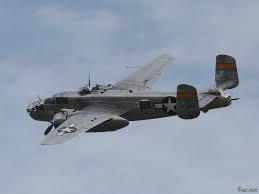 that took down the World Trade Center in Manhattan on Sept 11, 2001, an event that probably seemed eerily similar to those who were alive and living in New York City on July 28, 1945. The crash caused one million dollars in damage at that time, which would equate to about 10.5 million these days. For many people this was an event, much like 9-11 that would never be forgotten, even though it was not a terrorist attack, but rather a tragic accident.
that took down the World Trade Center in Manhattan on Sept 11, 2001, an event that probably seemed eerily similar to those who were alive and living in New York City on July 28, 1945. The crash caused one million dollars in damage at that time, which would equate to about 10.5 million these days. For many people this was an event, much like 9-11 that would never be forgotten, even though it was not a terrorist attack, but rather a tragic accident.
 Imagine being in a country where being afraid is a crime. I’m sure you are wondering how that is possible…in any country, but I assure you, it is. That was the case on this day, July 27, 1943 in Russia. Joseph Stalin was the premier and dictator of Russia at that time in history, and Adolf Hitler was the dictator of Germany. The Germans were advancing into Russian territory, and Stalin was determined to stop them, no matter the cost.
Imagine being in a country where being afraid is a crime. I’m sure you are wondering how that is possible…in any country, but I assure you, it is. That was the case on this day, July 27, 1943 in Russia. Joseph Stalin was the premier and dictator of Russia at that time in history, and Adolf Hitler was the dictator of Germany. The Germans were advancing into Russian territory, and Stalin was determined to stop them, no matter the cost.
Hitler had become quite bold because of the early successes against Russia in his goal of taking Leningrad and Stalingrad. The attack on Stalingrad proved, however, that the Russians had superior manpower and it was an enormous drain on German resources and troop strength. The Germans were repulsed by a fierce Soviet fighting force, that had been reinforced with more men and materials. Hitler made the decision to turn his sights to Leningrad.
Stalin needed to make sure his force wouldn’t back down…no matter what happened. The motivation to stand 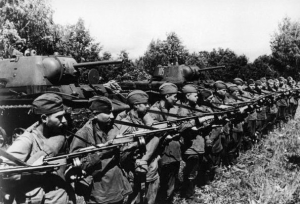 their ground needed to apply to both officers and civilians alike, or he was sure that Leningrad would be lost. That was when Stalin decided to put order number 227 into effect. So, what was order number 227? The order declared, “Panic makers and cowards must be liquidated on the spot. Not one step backward without orders from higher headquarters! Commanders…who abandon a position without an order from higher headquarters are traitors to the Fatherland.” Basically the order said that no one…not one person would be a coward. The order became known as the “not one step backward” order. The military personnel, as well as civilians were forced to fight for their city.
their ground needed to apply to both officers and civilians alike, or he was sure that Leningrad would be lost. That was when Stalin decided to put order number 227 into effect. So, what was order number 227? The order declared, “Panic makers and cowards must be liquidated on the spot. Not one step backward without orders from higher headquarters! Commanders…who abandon a position without an order from higher headquarters are traitors to the Fatherland.” Basically the order said that no one…not one person would be a coward. The order became known as the “not one step backward” order. The military personnel, as well as civilians were forced to fight for their city.
I think I can understand what Stalin was doing, but it seems such a drastic measure to take. Still, while some  people might fight the enemy to the end, others might decide that their city wasn’t worth their life. If the penalty for backing off was instant liquidation, then standing and fighting became the only way to have a chance at life. In my opinion, that as far as ways to gain loyalty goes, this was not the best of plans, but then forced loyalty seldom is. Still, one must never underestimate the love a patriot feels for their country. The “not one step backward” order was virtually unnecessary, in that on the day the order was issued, the Russian peasants and other supporters in the Leningrad region killed a German official, Adolf Beck, whose job was to send agricultural products from occupied Russia to Germany and to German troops. The Russian patriots also set fire to the granaries and barns in which the stash of agricultural products was stored before transport. A partisan pamphlet issued an order of its own: “Russians! Destroy the German landowners. Drive the Germans from the land of the Soviets!” I guess Stalin had misjudged his peoples’ loyalty.
people might fight the enemy to the end, others might decide that their city wasn’t worth their life. If the penalty for backing off was instant liquidation, then standing and fighting became the only way to have a chance at life. In my opinion, that as far as ways to gain loyalty goes, this was not the best of plans, but then forced loyalty seldom is. Still, one must never underestimate the love a patriot feels for their country. The “not one step backward” order was virtually unnecessary, in that on the day the order was issued, the Russian peasants and other supporters in the Leningrad region killed a German official, Adolf Beck, whose job was to send agricultural products from occupied Russia to Germany and to German troops. The Russian patriots also set fire to the granaries and barns in which the stash of agricultural products was stored before transport. A partisan pamphlet issued an order of its own: “Russians! Destroy the German landowners. Drive the Germans from the land of the Soviets!” I guess Stalin had misjudged his peoples’ loyalty.
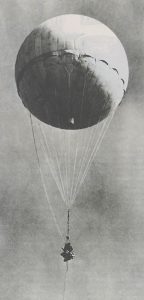 I suppose a true World War II history buff might know about some of the strange war stories there are out there, and I rather thought I was becoming a World War II history buff, but I had never heard of the Japanese Balloon Bombs. I can’t imagine how a nation could send a random bomb over another nation, not knowing where it will land, or who it will kill…but then, the evil we have seen in the 21st century has proven to be very much the same. I guess there really is nothing new under the sun. Where evil exists, horrible things happen. Such was the case with the Japanese Balloon Bombs. The Japanese were an evil nation at that time, and they didn’t care who they hurt. in 1945, a Japanese Balloon Bomb landed in rural Oregon, ad killed six people . As it turns out, these were the only World War II combat casualties within the continental 48 states. Apparently, the accuracy of the balloon bombs left something to be desired…thankfully.
I suppose a true World War II history buff might know about some of the strange war stories there are out there, and I rather thought I was becoming a World War II history buff, but I had never heard of the Japanese Balloon Bombs. I can’t imagine how a nation could send a random bomb over another nation, not knowing where it will land, or who it will kill…but then, the evil we have seen in the 21st century has proven to be very much the same. I guess there really is nothing new under the sun. Where evil exists, horrible things happen. Such was the case with the Japanese Balloon Bombs. The Japanese were an evil nation at that time, and they didn’t care who they hurt. in 1945, a Japanese Balloon Bomb landed in rural Oregon, ad killed six people . As it turns out, these were the only World War II combat casualties within the continental 48 states. Apparently, the accuracy of the balloon bombs left something to be desired…thankfully.
The idea of a balloon bomb was to send in a bomb that was silent. The problem is that balloons are hard to control. They go with the flow of the wind currents, so you don’t know where they will land. Then again, the Japanese were at war with the world, so they really didn’t care where the balloons would land. The six people who were killed by the Fu-Go or fire-balloon bomb, as they were called, were a Sunday School teacher Elyse Mitchell (and her unborn child), her 13 and 14 year old students, Jay Gifford, Edward Engen, Sherman Shoemaker, Dick Patzke, all of whom were killed instantly, when the bomb exploded. Dick Patzke’s sister, Joan was severely burned, and died moments later. The group had stopped for a moment, because Elyse Mitchell was feeling ill, and while her husband, Reverend Archie Mitchell talked with construction workers in the area, the six victims went to investigate a balloon they saw. It would prove to be a fatal mistake. The group had been going on a Saturday afternoon picnic near Klamath Falls, Oregon. They had only walked about 100 yards from the car. One of the road-crew workers, Richard Barnhouse, said “There was a terrible explosion. Twigs flew through the air, pine needles began to fall, dead branches and dust, and dead logs went up.”
Made of rubberized silk or paper, each balloon was about 33 feet in diameter. Barometer-operated valves released hydrogen if the balloon gained too much altitude or dropped sandbags if it flew too low. The balloons were filled with 19,000 cubic feet of hydrogen and the jet stream drew them eastward. They were designed to travel across the Pacific to North America, where they would drop incendiary devices or anti-personnel explosives. I would think the hydrogen alone would make a horrible bomb, but attached to the  balloon was the actual bomb. The Japanese released an estimated 9,000 fire balloons during the last months of World War II. At least 342 reached the United States, with some drifting as far as Nebraska. Some were shot down. Some caused minor damage when they landed, but no injuries. One hit a power line and blacked out the nuclear-weapons plant at Hanford, Washington. But the only known casualties from the 9,000 balloons…and the only combat deaths from any cause on the U S mainland were the five kids and their Sunday school teacher going to a picnic. What a valiant victory for the Japanese that was.
balloon was the actual bomb. The Japanese released an estimated 9,000 fire balloons during the last months of World War II. At least 342 reached the United States, with some drifting as far as Nebraska. Some were shot down. Some caused minor damage when they landed, but no injuries. One hit a power line and blacked out the nuclear-weapons plant at Hanford, Washington. But the only known casualties from the 9,000 balloons…and the only combat deaths from any cause on the U S mainland were the five kids and their Sunday school teacher going to a picnic. What a valiant victory for the Japanese that was.
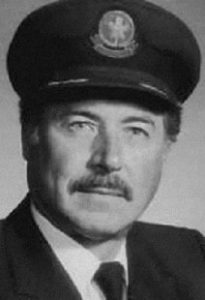
 Plane crashes are always tragic events. The loss of life and property is devastating. Sometimes, however, a pilot and his crew are able to pull off a landing in unbelievable circumstances. Something like that leaves everyone from the passengers, families, the NTSB, and the world scratching their heads in disbelief. Years ago I watched a movie about just such a flight. The flight was Air Canada Flight 143. A couple of days ago, I saw that it was the 33rd anniversary of that flight which occurred on July 23, 1983, and I thought about what a miracle that whole situation was. Canada Air had just made the conversion from pounds of fuel to kilograms of fuel. Unfortunately, as is often the case in these types of conversions, things were not converting as smoothly as the airline had hoped. On 22 July 1983, Air Canada’s Boeing 767, registered as C-GAUN, c/n 22520/47, from Toronto to Edmonton where it underwent routine checks. The next day, it was flown to Montreal. Following a crew change, it departed Montreal as Flight 143 for the return trip to Edmonton via Ottawa, with Captain Robert (Bob) Pearson and First Officer Maurice Quintal at the controls. The crew had been somewhat leery of taking off with the fuel indicator taped off as inoperable. It would seem logical to most of us that Air Canada should have waited until all systems were operable before using the plane, but that was not the case.
Plane crashes are always tragic events. The loss of life and property is devastating. Sometimes, however, a pilot and his crew are able to pull off a landing in unbelievable circumstances. Something like that leaves everyone from the passengers, families, the NTSB, and the world scratching their heads in disbelief. Years ago I watched a movie about just such a flight. The flight was Air Canada Flight 143. A couple of days ago, I saw that it was the 33rd anniversary of that flight which occurred on July 23, 1983, and I thought about what a miracle that whole situation was. Canada Air had just made the conversion from pounds of fuel to kilograms of fuel. Unfortunately, as is often the case in these types of conversions, things were not converting as smoothly as the airline had hoped. On 22 July 1983, Air Canada’s Boeing 767, registered as C-GAUN, c/n 22520/47, from Toronto to Edmonton where it underwent routine checks. The next day, it was flown to Montreal. Following a crew change, it departed Montreal as Flight 143 for the return trip to Edmonton via Ottawa, with Captain Robert (Bob) Pearson and First Officer Maurice Quintal at the controls. The crew had been somewhat leery of taking off with the fuel indicator taped off as inoperable. It would seem logical to most of us that Air Canada should have waited until all systems were operable before using the plane, but that was not the case.
The flight seemed to be going smoothly, but about half way between Montreal and Edmonton, at an altitude on 41,000 feet, the aircraft’s cockpit warning system sounded, indicating a fuel pressure problem on the aircraft’s left side. Assuming a fuel pump had failed, the pilots turned it off, since gravity should feed fuel to the aircraft’s two engines. In most situations, that would have worked, but when the plane was fueled, the technician failed to accurately convert the fuel from pounds to kilograms, and the plane had run out of fuel. Running out of fuel  in a small plane, flying at much lower altitudes has been known to get people killed, but this was a Boeing 767, and it was at an altitude of 41,000 feet. This had all the makings of a disaster…but somehow, that was not what happened. In this case, the event would prove to be the finest hour for the pilot and crew.
in a small plane, flying at much lower altitudes has been known to get people killed, but this was a Boeing 767, and it was at an altitude of 41,000 feet. This had all the makings of a disaster…but somehow, that was not what happened. In this case, the event would prove to be the finest hour for the pilot and crew.
The passengers on this plane had the unusual advantage of having at the controls, a pilot who was an experienced glider pilot. Now, as you know gliders have no fuel in them. You are pulled into the air by another plane and then released to glide in for a landing. That’s an easy enough task for a trained glider pilot in a glider plane, but this was a modern day, wide body jet. The idea of gliding this plane in for a safe landing was…well, unheard of. Robert “Bob” Pearson was that pilot, and with the help of his crew and an air traffic controller, he safely glided the plane into an abandoned Royal Canadian Air Force airstrip that was being used as a drag strip…at the very moment of the landing of the plane. The men could not see that, however, until they were almost on top of the people. Thankfully, the people on the runway saw the plane and got out of the way.
The crew had hoped to make Winnipeg, but with the best glide speed and the rate of descent, there was no way. Then, Quintal remembered Gimli, and the abandoned strip became their last hope. They were too high for it, so Pearson performed a slip, which is a glide maneuver to increase drag, causing the plane to lose altitude quickly. To add to the problem, the nose gear came down, but did not lock as the rest of the gear had. Could things have been more dire? In the end, Captain Pearson executed the landing perfectly, in spite of all of the problems, and the fact that the Winnipeg Sports Car Club was on the field with everything needed to assist in 
 this emergency, the plane landed without a single death in the plane or on the ground, and the fuel starvation scenario became part of the pilots training in their simulators. The first pilots to try the program in the simulator all crashed, and believed that it was an impossible scenario, until they were told that it had happened, and that the pilot landed safely. The flight has since been dubbed the Gimli Glider. And, that’s a miracle for the books.
this emergency, the plane landed without a single death in the plane or on the ground, and the fuel starvation scenario became part of the pilots training in their simulators. The first pilots to try the program in the simulator all crashed, and believed that it was an impossible scenario, until they were told that it had happened, and that the pilot landed safely. The flight has since been dubbed the Gimli Glider. And, that’s a miracle for the books.
 If I tell you that there exists in this world, a children’s railway, would you think of the Orphan Train, bringing children out West for adoption into families there? Or would you think of some kind of forced child labor on the railways? Either way…you would be wrong. The Children’s Railway was started in Soviet Russia in 1932. The concept is a unique one. The idea was to teach teenaged children to build and run a railroad as a way of learning the railroad trade. It was an extracurricular activity that was voluntary. Things like that aren’t offered in this country…at least not that I’m aware of. Nevertheless, I think my grandfather, Allen Luther Spencer might have enjoyed that, had it been offered in his time. I also think that my cousin by marriage, James Forseen, might have loved that since he has always loved trains, and managed to land a job with the railroad. He loved them so much that he had to have one in the wedding photos when he
If I tell you that there exists in this world, a children’s railway, would you think of the Orphan Train, bringing children out West for adoption into families there? Or would you think of some kind of forced child labor on the railways? Either way…you would be wrong. The Children’s Railway was started in Soviet Russia in 1932. The concept is a unique one. The idea was to teach teenaged children to build and run a railroad as a way of learning the railroad trade. It was an extracurricular activity that was voluntary. Things like that aren’t offered in this country…at least not that I’m aware of. Nevertheless, I think my grandfather, Allen Luther Spencer might have enjoyed that, had it been offered in his time. I also think that my cousin by marriage, James Forseen, might have loved that since he has always loved trains, and managed to land a job with the railroad. He loved them so much that he had to have one in the wedding photos when he  married my cousin Dani Byer Forseen. Just imagine James, if you could have worked on a railroad in high school!!
married my cousin Dani Byer Forseen. Just imagine James, if you could have worked on a railroad in high school!!
As I said, the children’s railway was a phenomenon that originated in the USSR. The first Children’s Railway opened in Gorky Park in Moscow, on July 24, 1932. It was a greatly developed activity in Soviet times. By the time the USSR broke up, there were 52 children’s railways in existence in that country. Many children’s railways are still functioning in post-Soviet states and in Eastern Europe, so obviously this is an activity that has taken off…and imagine the kids who would stay out of trouble if they fell in love with railroad work. I can envision the kids having such a great time running the railroad that they would never have the time or the inclination to get into trouble or into gangs. Their imagination would be too busy.
The children’s railway has come so far that many of them exhibit railway technology not seen anymore on the  main lines and they can be seen as heritage railways. Even though a few exceptions exist, most of the children’s railways that were built in the communist block have a track gauge of at least 600 mm (1 feet 11 5/8 inches) and can carry full size narrow gauge rolling stock. Of course, for the sake of safety and training purposes, the children’s railways are all run under the supervision of adult railroad workers, but what better way for things to be done. The children’s railways in existence these days are mostly for the purpose of tourism, but I suppose that if necessary, they could be used for other reasons. Whatever their purpose is today, I think the Children’s Railways sound like a very cool idea.
main lines and they can be seen as heritage railways. Even though a few exceptions exist, most of the children’s railways that were built in the communist block have a track gauge of at least 600 mm (1 feet 11 5/8 inches) and can carry full size narrow gauge rolling stock. Of course, for the sake of safety and training purposes, the children’s railways are all run under the supervision of adult railroad workers, but what better way for things to be done. The children’s railways in existence these days are mostly for the purpose of tourism, but I suppose that if necessary, they could be used for other reasons. Whatever their purpose is today, I think the Children’s Railways sound like a very cool idea.

 When two people are as great together as my nephew, Garrett Stevens and his bride, Kayla Smiley, you tend to think of them as already married. They are in tune with each other, and so happy. They have so much in common, and they are such good friends. Nevertheless, until today, they haven’t been married…just perfect for each other.
When two people are as great together as my nephew, Garrett Stevens and his bride, Kayla Smiley, you tend to think of them as already married. They are in tune with each other, and so happy. They have so much in common, and they are such good friends. Nevertheless, until today, they haven’t been married…just perfect for each other.
Today, all that will change as they take their vows and become husband and wife. When you watch someone grow up from birth, it is a strange thing to see them suddenly all grown up and getting married. That is the case with my nephew, Garrett Stevens. Garrett was a happy kid, who always had a smile on his face. Of course, that hasn’t changed, but these days that smile is there because of how happy he is with Kayla. She completes him and he completes her.
Kayla is a sweet girl, with a sweet and gentle heart. The little kids love her as much as they do Garrett. In fact, if they were allowed to they would probably spend all of their time with them. I guess that’s how it is when you don’t mind having some kid time in your life. It makes me think that someday Garrett and Kayla will make wonderful parents. Of course, that will be another story…someday. Garrett has always loved the little kids in the family, and I think Kayla is on the same page with him on that.
Today, as Garrett and Kayla embark on the first day of the rest of their lives, I think it is with mixed emotions 
 that most of us view this wonderful ceremony. Of course, the part about them becoming husband and wife is wonderful and exciting, but for their parents…there is still that little hint of loss. The loss of their babies. How could they have grown up so fast? It seems like they were just born yesterday!! Be that as it may, their parents will now find that it’s not really about losing a daughter or son, but about gaining a daughter-in-law or son-in-law. The two become one, and then they go on together to make the most wonderful life ever. The direction their lives will take them is up to them, of course, but I know that their lives will be completely amazing. Today is Garrett and Kayla’s wedding day. Congratulations Garrett and Kayla!! It’s an awesome day. Congratulations!! We love you both!!
that most of us view this wonderful ceremony. Of course, the part about them becoming husband and wife is wonderful and exciting, but for their parents…there is still that little hint of loss. The loss of their babies. How could they have grown up so fast? It seems like they were just born yesterday!! Be that as it may, their parents will now find that it’s not really about losing a daughter or son, but about gaining a daughter-in-law or son-in-law. The two become one, and then they go on together to make the most wonderful life ever. The direction their lives will take them is up to them, of course, but I know that their lives will be completely amazing. Today is Garrett and Kayla’s wedding day. Congratulations Garrett and Kayla!! It’s an awesome day. Congratulations!! We love you both!!
 The first time I saw my cousin, Michelle Deraas Carlson, I thought, “What a teeny little girl she is!!” It’s true that Michelle, who is my cousin by her marriage to my cousin, Dave Carlson back in 1981, is a little girl of less that five feet, but don’t make the mistake of thinking that she is a fragile little girl. You would find that you are wrong, because Michelle is one tough lady. No, she’s not a fighter…she’s a personal trainer at Fitness Edge North in Duluth, Minnesota, which is owned by her sister-in-law, Julie Soukup.
The first time I saw my cousin, Michelle Deraas Carlson, I thought, “What a teeny little girl she is!!” It’s true that Michelle, who is my cousin by her marriage to my cousin, Dave Carlson back in 1981, is a little girl of less that five feet, but don’t make the mistake of thinking that she is a fragile little girl. You would find that you are wrong, because Michelle is one tough lady. No, she’s not a fighter…she’s a personal trainer at Fitness Edge North in Duluth, Minnesota, which is owned by her sister-in-law, Julie Soukup.
If you choose to hire her to get you in shape, you will find that she can get the job done. Now, she will tell you that this won’t be easy…and you might want to quit, but if you don’t give up, you will find yourself looking a great as she does. Of course, she’s  not one to brag…that part was all me. I’ve never had the privilege of using Michelle as a personal trainer myself, because I live too far away, but I have done…or at least tried to keep up with…some of her workouts. I had the opportunity to do some of her workouts by going to her Facebook site recently, and I could see that I was going to have to work very hard if I was going to be able to keep up. She is in great shape, and her workouts will wear you out…unless you are in pretty good shape too. At the time I saw her video, I was recovering from a broken shoulder. I was not able to do all of the exercises she did, but I hope to be able to in the future.
not one to brag…that part was all me. I’ve never had the privilege of using Michelle as a personal trainer myself, because I live too far away, but I have done…or at least tried to keep up with…some of her workouts. I had the opportunity to do some of her workouts by going to her Facebook site recently, and I could see that I was going to have to work very hard if I was going to be able to keep up. She is in great shape, and her workouts will wear you out…unless you are in pretty good shape too. At the time I saw her video, I was recovering from a broken shoulder. I was not able to do all of the exercises she did, but I hope to be able to in the future.
 Michelle is definitely a short girl, but she embraces it. Like many of us who are short (although maybe not quite as short as she is) being short is not a bad thing. We might have to have someone reach the stuff in the cupboard that is far beyond our grasp, but we don’t have to worry about having someone standing in front of us in pictures, because with our short stature, we always have to be in front, or the camera would miss us altogether. Michelle might be the shortest person in her family, but they all love her just the way she is. She always has a smile on her face, and she is there to help with anything that is needed. It doesn’t get any better than that in a family. Today is Michelle’s birthday. Happy birthday Michelle!! Have a great day!! We love you!!
Michelle is definitely a short girl, but she embraces it. Like many of us who are short (although maybe not quite as short as she is) being short is not a bad thing. We might have to have someone reach the stuff in the cupboard that is far beyond our grasp, but we don’t have to worry about having someone standing in front of us in pictures, because with our short stature, we always have to be in front, or the camera would miss us altogether. Michelle might be the shortest person in her family, but they all love her just the way she is. She always has a smile on her face, and she is there to help with anything that is needed. It doesn’t get any better than that in a family. Today is Michelle’s birthday. Happy birthday Michelle!! Have a great day!! We love you!!
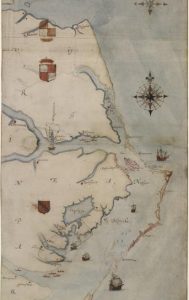 When I think of a lost people, I think of a tribe in Africa or somewhere very isolated, but I never think of someplace in America! Nevertheless, it happened right here in America. Of course, it was a long…long time ago. It was long before people could easily track someone down. The year was 1587, the day was July 22. That was the day when the new colony arrived in Roanoke, North Carolina, which was colonial Virginia. On August 18, 1587, the first English baby to be born in the Americas, Virginia Dare was born. The group had been dispatched by Sir Walter Raleigh, and was led by John White, who by the way, was Virginia Dare’s grandfather. Upon their arrival, they found nothing of the English garrison that had gone ahead, except one skeleton. The people really didn’t want to stay there after that, but the fleet commander, Simon Fernandez would not let them return to the ship, and the ships sailed with the promise of new supplies to come.
When I think of a lost people, I think of a tribe in Africa or somewhere very isolated, but I never think of someplace in America! Nevertheless, it happened right here in America. Of course, it was a long…long time ago. It was long before people could easily track someone down. The year was 1587, the day was July 22. That was the day when the new colony arrived in Roanoke, North Carolina, which was colonial Virginia. On August 18, 1587, the first English baby to be born in the Americas, Virginia Dare was born. The group had been dispatched by Sir Walter Raleigh, and was led by John White, who by the way, was Virginia Dare’s grandfather. Upon their arrival, they found nothing of the English garrison that had gone ahead, except one skeleton. The people really didn’t want to stay there after that, but the fleet commander, Simon Fernandez would not let them return to the ship, and the ships sailed with the promise of new supplies to come.
John White was not allowed to stay, and so returned to England on August 27, 1587…vowing to return in three months time. That was about the time of the Spanish Armada attack in 1588, which delayed White’s return to Roanoke. White tried desperately to return to the little colony for the next three years. When he was finally able to get there, he came rushing onshore, only to find that the colony was gone. 
 Among those missing was the little girl, Virginia Dare, White’s granddaughter. They had arrived on what would have been her third birthday…August 15. Whites return was delayed because of the Anglo-Spanish war, and the Spanish ships that robbed the expedition of the supplies they were taking over to the colonists. It is suspected that the colony disappeared during that war, but there is no clear clarification as to where they went or who took them.
Among those missing was the little girl, Virginia Dare, White’s granddaughter. They had arrived on what would have been her third birthday…August 15. Whites return was delayed because of the Anglo-Spanish war, and the Spanish ships that robbed the expedition of the supplies they were taking over to the colonists. It is suspected that the colony disappeared during that war, but there is no clear clarification as to where they went or who took them.
There has been much speculation as to the fate of the Roanoke Lost Colony, but the sure fate of the settlers left behind is unknown and the colony is known as the “Lost Colony” of Roanoke to this day. Over the years numerous attempts have been made to find the Lost Colony, including the Lost Colony DNA Project started in 2005. Recent investigations speculate that the Lost Colony relocated to where the Chowan River meets the Albemarle Sound in present day Bertie County, North Carolina. Nevertheless, recent discoveries found 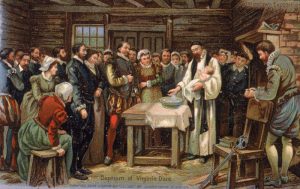 European objects in the Hatteras Island area, including a sword hilt, broken English bowls, and a fragment of a slate writing tablet still inscribed with a letter. These could point to the presence of the colonists on Hatteras Island, some 50 miles southeast of their settlement on Roanoke Island. There were also some found at a site on the mainland 50 miles to the northwest. Some people have thought that the Native Americans took the people or at least assimilated them into their tribe, because there are in some of that modern day tribe of people with strangely gray eyes. I suppose we will never really know the reality of what happened, but I would rather think that the Native Americans took them in, than to think that they were killed.
European objects in the Hatteras Island area, including a sword hilt, broken English bowls, and a fragment of a slate writing tablet still inscribed with a letter. These could point to the presence of the colonists on Hatteras Island, some 50 miles southeast of their settlement on Roanoke Island. There were also some found at a site on the mainland 50 miles to the northwest. Some people have thought that the Native Americans took the people or at least assimilated them into their tribe, because there are in some of that modern day tribe of people with strangely gray eyes. I suppose we will never really know the reality of what happened, but I would rather think that the Native Americans took them in, than to think that they were killed.
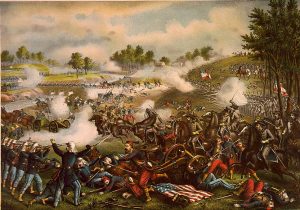 People don’t think of war as being something they want to send their children into…much less witness one themselves, or even one battle of a war. War really isn’t a spectator sport, after all. Nevertheless, there was a time, when people didn’t really seem to realize that. Early in the Civil War, the Union military command believed that the Confederate army could be easily defeated, and that the war would be over very quickly and with very little loss of life.
People don’t think of war as being something they want to send their children into…much less witness one themselves, or even one battle of a war. War really isn’t a spectator sport, after all. Nevertheless, there was a time, when people didn’t really seem to realize that. Early in the Civil War, the Union military command believed that the Confederate army could be easily defeated, and that the war would be over very quickly and with very little loss of life.
In July of 1861, the folly of that overconfidence was sharply pointed out when General Irvin McDowell led a premature offensive into northern Virginia. He set out in search of the Confederate forces, leading 34,000 mostly inexperienced troops, who were also poorly trained, toward the railroad junction of Manassas, which is just 30 miles from Washington DC. General Beauregard of the Confederate forces, was alerted of the advance, and so brought together 20,000 troops there. He was soon joined by General Joseph Johnston, who brought 9,000 additional men by way of railroad.
On the morning of July 21, 1861, the people of the area heard of the opposing forces, and that a battle was about to break out in their vicinity. Hundreds of civilian men, women, and children turned up to watch the first major battle of the Civil War. The fighting commenced with three Union divisions crossing the Bull Run stream. The Confederate flank was driven back to Henry House Hill. General Beauregard had set up a strong defensive line backed up by a brigade of Virginia infantry under General Thomas Jackson. From a concealed slope, Jackson’s men began firing a series of Federal charges. It was this plan that gave Jackson his famous nickname Stonewall. The Confederate cavalry under J.E.B. Stuart captured the Union artillery, and General Beauregard ordered a counterattack on the exposed Union right flank. The rebels came charging down the hill, yelling furiously, and General McDowell’s line was broken, forcing his troops in a hasty retreat across Bull Run. The retreat soon became an all out run for their lives, and supplies littered the road back to Washington. Union forces endured a loss of 3,000 men killed, wounded, or missing in action while the Confederates suffered 2,000 casualties in the bloody battle.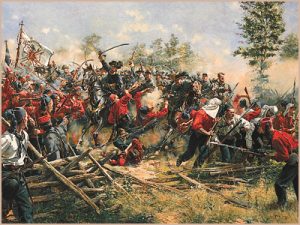
The horrific battle not only the frightened spectators at Bull Run, but the United States government in Washington as well, which was faced with an uncertain military strategy that would obviously need to change, if the South was to be stopped. I have a hard time understanding how the people could possibly have thought this was something to go out and watch…much less to take their children to. Of course, these days I think we have seen so much war on television, that no one in their right mind would go to watch a battle and no one would take their kids, because war is not a spectator sport.

